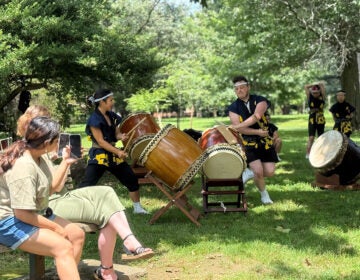Students make video odes to the elements
Daniyal Khan does not think of himself as a scientist. The junior at Berlin High School in Connecticut is more interested in shooting and editing videos, and he knew that a hydrogen explosion would be a crowd-pleaser.
“I want a big ending,” said Khan. “I want to go out with a bang.”
His five-minute video explaining the properties and applications of hydrogen won him a top prize in the Chemical Heritage Foundation’s “It’s Elemental” video contest, and his school $5,000.
To celebrate 2011 as the “International Year of Chemistry,” the CHF in Philadelphia and Dow Chemical asked high schools students around the country to make videos about their favorite element from the Periodic Table.
Khan learned there’s more to good science than just research.
“You got to be able to present it in a way that every person will find it interesting, and entertaining,” said Khan, 16.
Seven hundred videos were submitted, representing nearly all elements on the Periodic Table. It benefitted the panel of judges as much as it did the students.
“You hear so much press about how students aren’t interest in chemistry, and there was clear enthusiasm–and depth of understanding,” said Katie Hunt, a contest judge and scientist at Dow Chemical. “It made us take a look and say: we really need to engage with these kids, because they know so much.”
The judges wanted to see an understanding of the element’s properties, their historical context, and their applications. The videos (all on display at www.chemheritage.org) range from painfully amateurish to future Ken Burns.
Joy Becker and her partners at Southwest High School in Lincoln, Nebraska utilized the famous Burnsian pan in their award-winning video for gadolinian, an obscure element on the bottom of the Table.
Gadolinium was not their first choice; they would have preferred fluorine because it would have enabled them to experiment cheaply with toothpaste instead of industrial-grade gadolinium, which goes for about $500 a kilogram.
They got stuck with gadolinium because they were late registering and it was one of the only elements still available for the contest. But they learned a lot from number 64.
“If you raise it above a certain temperature it will lose its magnetism. And if you put it in a magnetic field, the temperature will increase,” said Becker, 17. “Those are relationships between temperature and magnetism that I had no idea existed in any element, let alone gadolinium.”
The Chemical Heritage Foundation’s exhibition hall on Chestnut Street is currently displaying artistic interpretations of the elements–called “The Period Table Printmaking Project.”–which takes more poetic liberties than the student’s videos. They can be seen at www.azuregrackle.com.
WHYY is your source for fact-based, in-depth journalism and information. As a nonprofit organization, we rely on financial support from readers like you. Please give today.




